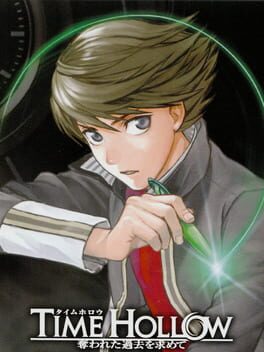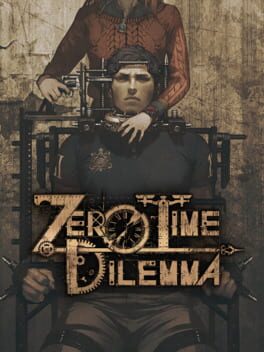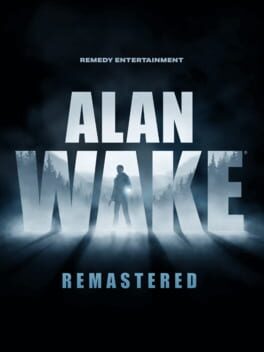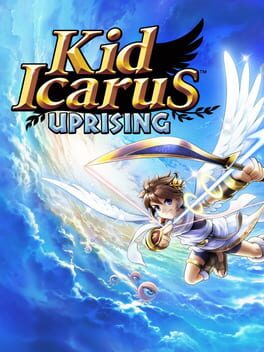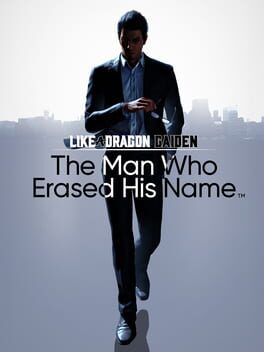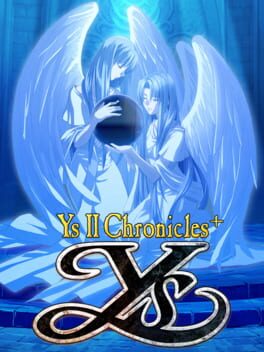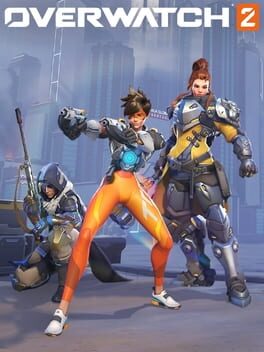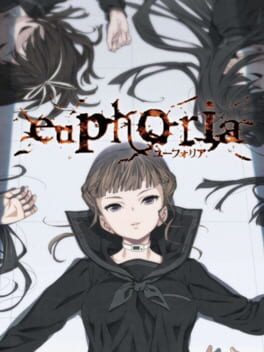Haypil
33 Reviews liked by Haypil
Time Hollow
2008
I'm sorry, am I meant to be angry? Am I supposed to be mad that this game sucks ass? It is genuinely hilarious how bad every aspect of this game is. I can't help but laugh anytime I imagine someone who unironically thought Zero Time Dilemma was the best visual novel ever made back in 2012, waiting day after day that the sequel to your favorite series (which might I add only continued due to fan support) strikes lightning in a bottle twice, and when it finally does, you get this shit. How can I be mad? This is hilarious!
Zero Time Dilemma is the Shenmue 3 of Visual Novels, the Hunt Down The Freeman of mystery stories, and the fact that this was well recieved upon release only fuels my conviction that Uchikoshi is a hack with Naoki Urasawa Syndrome and can only write the same mystery story every time no matter how many stories he makes. The schadenfreude I get from shit talking this game is unparalleled, there's really no point in trying to make a coherent train of thought for ZTD but since it's so bad it warps itself into being funny, I think there are a few noteworthy thinks that make it an enjoyable experience compared to Virtue's Last Reward for me despite my score.
- The model quality is a surprising step up from VLR but jesus the animations on these are hilariously awful, Eric is always laughing no matter the occasion, the lip flaps aren't even close to matching on either language and everyone moves like puppets on a string, it makes Sonic Adventure 2's cutscenes look professional.
- What I tend to like the most about visual novels is how you can read the story at your own pace, be it a speedreader or an overanalyser, everyone can process the story at different intervals that make them comfortable with the experience. Throwing that out the window is a daringly bold move if you don't consider that they were trying to rip off telltale games's approach to gameplay with cutscene work that only rivals Yandere Simulator
- The escape rooms are pretty much the only thing that is consistent with the rest of the series to compensate for the neutered returning characters, but the flowchart is probably the worst one of out all, not only is it needlessly long, but the disordered nature of it's structure means you'll be clicking aimlessly through out of order events which feel like extremely inconsequential stepping stones until you reach that wet fart of an ending.
- It is clear that Uchikoshi wrote himself into a corner since VTL, and though I can feel pity on him, Zero escape is nowhere near the top 5 most convoluted and complex video game narratives, let alone for visual novels, so he only has himself to blame for making this jenga tower of a plot structure and failing to stick the landing.
- Multiverse theory is a load of horseshit and did irreperable damage to science fiction.
Zero Time Dilemma is the Shenmue 3 of Visual Novels, the Hunt Down The Freeman of mystery stories, and the fact that this was well recieved upon release only fuels my conviction that Uchikoshi is a hack with Naoki Urasawa Syndrome and can only write the same mystery story every time no matter how many stories he makes. The schadenfreude I get from shit talking this game is unparalleled, there's really no point in trying to make a coherent train of thought for ZTD but since it's so bad it warps itself into being funny, I think there are a few noteworthy thinks that make it an enjoyable experience compared to Virtue's Last Reward for me despite my score.
- The model quality is a surprising step up from VLR but jesus the animations on these are hilariously awful, Eric is always laughing no matter the occasion, the lip flaps aren't even close to matching on either language and everyone moves like puppets on a string, it makes Sonic Adventure 2's cutscenes look professional.
- What I tend to like the most about visual novels is how you can read the story at your own pace, be it a speedreader or an overanalyser, everyone can process the story at different intervals that make them comfortable with the experience. Throwing that out the window is a daringly bold move if you don't consider that they were trying to rip off telltale games's approach to gameplay with cutscene work that only rivals Yandere Simulator
- The escape rooms are pretty much the only thing that is consistent with the rest of the series to compensate for the neutered returning characters, but the flowchart is probably the worst one of out all, not only is it needlessly long, but the disordered nature of it's structure means you'll be clicking aimlessly through out of order events which feel like extremely inconsequential stepping stones until you reach that wet fart of an ending.
- It is clear that Uchikoshi wrote himself into a corner since VTL, and though I can feel pity on him, Zero escape is nowhere near the top 5 most convoluted and complex video game narratives, let alone for visual novels, so he only has himself to blame for making this jenga tower of a plot structure and failing to stick the landing.
- Multiverse theory is a load of horseshit and did irreperable damage to science fiction.
Clannad
2004
Alan Wake Remastered
2021
Alan Wake Remastered
2021
I adore how Alan Wake is actually one of the most bland New York Times Best Seller type writers imaginable and how that's reflected throughout the whole game while everyone takes his shit deadly seriously. I think my opinion of the game overall is held up by that aspect of the writing and the fact that there is more foggy-woods-at-night per square inch in this game than in any other game I can think of, and that's one of the best settings imaginable. The core gameplay mechanics of managing a mob of enemies with a flashlight and limited resources are really interesting and enjoyable for the first half of the game, but once they honestly just run out of ideas for compelling encounters in the back half and there are so many encounters between story beats that it just becomes a slog.
Alan Wake Remastered
2021
This review contains spoilers
This is supposed to be a horror game, right? Alan loved saying his book was "turning into a horror story" but nothing about this game was even a little spooky. It was more silly than it was intense.
The gameplay hurts Alan Wake the most. Flashlight before damage gimmick gets old after enough fighting, and a lot of the gameplay relies on constant shooting.
Something which I find such an obviously terrible decision is the camera. It switches shoulders constantly while playing and defaults to the left side. There is a button to switch the camera to the opposite side it is on, and having to constantly move it to the right shoulder got irritating quick. It baffles me that there is not a setting to keep the camera from moving.
I'd expect that option to be in a 2021 remaster. This being such a recent remaster is quite insane to me, it is missing so much that could potentially make this more justified. The graphics aren't terribly better than the original and animations were just not changed at all, including the odd facial animations.
Each episode often repeats itself in both layout and environment. It has a starting location and an end goal to reach, with a forest somewhere between. The forests all feel the same, almost never with defining set pieces. The exception is the last episode, which throws in many random things to make it feel special like a junk yard or a random monster truck encounter.
The pacing is slow, each episode feels same-y, just going through the motions until it tells you a new piece of information. Fortunately the core story has an interesting premise, enough to keep me engaged while slogging through endless combat. The dialogue is sloppy and is almost never delivered like a real person is speaking. I didn't find myself interested in a single character except for Alan himself.
Surprisingly my favorite thing about Alan Wake was the sweeping B-roll of the wilderness. It plays regularly and really gave a sense of how vast the nature surrounding Bright Falls was.
Rolling credits with 'Space Oddity' really did have me laughing at first but after a minute it made more sense. To me it hinted at what is happening with Alan after the game ends, likely stranded in cauldron lake awaiting an unlikely rescue (knowing Alan Wake 2 exists does kill this mystery a bit). The lyrics sorta fit but the vibe of the song definitely does not.
The gameplay hurts Alan Wake the most. Flashlight before damage gimmick gets old after enough fighting, and a lot of the gameplay relies on constant shooting.
Something which I find such an obviously terrible decision is the camera. It switches shoulders constantly while playing and defaults to the left side. There is a button to switch the camera to the opposite side it is on, and having to constantly move it to the right shoulder got irritating quick. It baffles me that there is not a setting to keep the camera from moving.
I'd expect that option to be in a 2021 remaster. This being such a recent remaster is quite insane to me, it is missing so much that could potentially make this more justified. The graphics aren't terribly better than the original and animations were just not changed at all, including the odd facial animations.
Each episode often repeats itself in both layout and environment. It has a starting location and an end goal to reach, with a forest somewhere between. The forests all feel the same, almost never with defining set pieces. The exception is the last episode, which throws in many random things to make it feel special like a junk yard or a random monster truck encounter.
The pacing is slow, each episode feels same-y, just going through the motions until it tells you a new piece of information. Fortunately the core story has an interesting premise, enough to keep me engaged while slogging through endless combat. The dialogue is sloppy and is almost never delivered like a real person is speaking. I didn't find myself interested in a single character except for Alan himself.
Surprisingly my favorite thing about Alan Wake was the sweeping B-roll of the wilderness. It plays regularly and really gave a sense of how vast the nature surrounding Bright Falls was.
Rolling credits with 'Space Oddity' really did have me laughing at first but after a minute it made more sense. To me it hinted at what is happening with Alan after the game ends, likely stranded in cauldron lake awaiting an unlikely rescue (knowing Alan Wake 2 exists does kill this mystery a bit). The lyrics sorta fit but the vibe of the song definitely does not.
Alan Wake Remastered
2021
unfortunately doesn't really live up to the works it keeps reminding you it's inspired by. i love twin peaks, and i like the twilight zone a bit as well, but what i like about both of those works is the dense symbolism, story beats that work emotionally before logically, and the societal messaging. alan wake's story doesn't really have any of those things? it's not flat-out badly written at all, but i was left disappointed with the story because it shoots really high and keeps reminding you of that... but it doesn't really pan out into much more than a pretty uninteresting dark vs light contemporary fantasy story. there's some interesting stuff it could get into regarding writer's block and death of the author, but alan wake doesn't get too far into that, which is a real shame. i'd be able to get past this stuff if the game wasn't so obsessed with reminding you that it's supposed to be like twin peaks (seriously? the lamp lady? cmon), and i'm not holding this stuff against remedy's future installments bc there are definitely some flashes of brilliance occasionally here, just not enough to carry the story above average to me. character writing is great here though, very enjoyable and likable. when the game takes itself less seriously and allows that stuff to shine, the story is pretty fun.
as for gameplay, alan wake is a mixed bag for sure. the light system is innovative and a pretty cool idea, but enemies take too long to kill for how many the game throws at you, and the game pretty frequently forces you to kill a group of enemies before moving on. i don't think making a survival horror game more actiony is a bad idea inherently, but the waves upon waves of enemies feel present more to waste your time than to provide scares, and i never really found myself running out of resources and feeling unempowered. the hordes of enemies also feels very awkwardly integrated with the story, as it's a suuuper corny zombie-movie esque gameplay style that is being put up next to a (generally) dead serious surreal horror story. outside of the combat though, there are some interesting ideas here. alan wake is much more open than you'd expect for a cinematic set-piece type of game, which is pretty cool. i don't really find the forest setting most of the game takes place in to be too fun to explore, but i do respect the effort and i think the player is well-incentivized to engage w their environment through stuff like the manuscript pages.
always cool to get more story in a game like this, especially considering the focus of the story here.
as for gameplay, alan wake is a mixed bag for sure. the light system is innovative and a pretty cool idea, but enemies take too long to kill for how many the game throws at you, and the game pretty frequently forces you to kill a group of enemies before moving on. i don't think making a survival horror game more actiony is a bad idea inherently, but the waves upon waves of enemies feel present more to waste your time than to provide scares, and i never really found myself running out of resources and feeling unempowered. the hordes of enemies also feels very awkwardly integrated with the story, as it's a suuuper corny zombie-movie esque gameplay style that is being put up next to a (generally) dead serious surreal horror story. outside of the combat though, there are some interesting ideas here. alan wake is much more open than you'd expect for a cinematic set-piece type of game, which is pretty cool. i don't really find the forest setting most of the game takes place in to be too fun to explore, but i do respect the effort and i think the player is well-incentivized to engage w their environment through stuff like the manuscript pages.
always cool to get more story in a game like this, especially considering the focus of the story here.
Alan Wake Remastered
2021
Imagine you’re watching a really solid tv show, with a vibe similar to Twin Peaks or season 1 of Stranger Things. Now imagine if instead of being interrupted by 1 or 2 minutes of commercials for every 5 minutes of story, you are interrupted by AN HOUR of garbage gameplay for every 5 minutes of story. The interesting story can’t redeem the truly terrible combat. Controlling the insufferable moron that is Alan feels like drunk driving a forklift. Alan will repeatedly die while blankly staring at the weapon you are trying to pick up. Alan will get stuck on ledges that must be climbed over to progress. Alan will miraculously miss shots at point blank range. Alan will get stun-locked by enemies that silently spawn behind him. There is no level variety or enemy variety. There is no interesting challenge. You are shooting at guys with hatchets in a forest for the entire game. I completed this game purely out of spite and stubbornness.
Kid Icarus: Uprising
2012
First of all I'm not a fan of Kiryu being brought back for LAD7, LAD:Gaiden and in LAD8 as a main character. The game itself was okay enough even being one of the worst in the series. Except for the last big fight and the ending scene (i cried so much)
LAD Gaidens narrative deals with the gap between the conclusion of LAD6 and Kiryu's cameo appearance in LAD7 and is primarily set in Sotenbori.
The weakest aspect of the story lies in its antagonists – thinly written and arguably the least compelling in all LAD games. Nearly all side characters suffer due to the relatively short plot. Though the characters are still cool and well-crafted, they lack depth.
Hanawa and Akame are exceptions, with Akame's character unfolding only through the progression of the Akame Network level.
Speaking of which. There are no regular side stories. All side stories are only accessible through the Akame Network (except for a handful in the Coliseum). Unfortunately, the quests are repetitive and monotonous, with very few offering a substantial story and interesting characters. Every LAD fan will remember the numerous "Toilet Drama" quests and how entertaining they were, despite their simple structure.
In Gaiden, it's genuinely just a simple fetch quest. Unfortunately, this is the case for a majority of them.
That is perhaps my biggest criticism of the whole game. I only realized how much I misses substories in Gaiden when I played the LAD8 demo and the three substories included in it.
Aside from that, Gaiden offers numerous fun activities and side stuff, allowing me to reach almost 30 hours of total playtime despite the short main quest. There's a challenging Coliseum with engaging fights, the comeback of Pocket Circuit, a Sega Master System with 12 games (US and Japanese Versions), as always a Sega Arcade - including Daytona USA 2 - and the usual minigames like hostess dating, poker, mahjong, etc.
Despite the somewhat "negative" review, I had a good time with the game, and I believe every LAD fan will have a good time too.
Personally, I would consider it the weakest LAD game, mainly due to the underdeveloped story and missing substories.
You can definitely tell that this game was planned as a short DLC for LAD7 and was bloated afterwards to sell it as a Full Game.
LAD Gaidens narrative deals with the gap between the conclusion of LAD6 and Kiryu's cameo appearance in LAD7 and is primarily set in Sotenbori.
The weakest aspect of the story lies in its antagonists – thinly written and arguably the least compelling in all LAD games. Nearly all side characters suffer due to the relatively short plot. Though the characters are still cool and well-crafted, they lack depth.
Hanawa and Akame are exceptions, with Akame's character unfolding only through the progression of the Akame Network level.
Speaking of which. There are no regular side stories. All side stories are only accessible through the Akame Network (except for a handful in the Coliseum). Unfortunately, the quests are repetitive and monotonous, with very few offering a substantial story and interesting characters. Every LAD fan will remember the numerous "Toilet Drama" quests and how entertaining they were, despite their simple structure.
In Gaiden, it's genuinely just a simple fetch quest. Unfortunately, this is the case for a majority of them.
That is perhaps my biggest criticism of the whole game. I only realized how much I misses substories in Gaiden when I played the LAD8 demo and the three substories included in it.
Aside from that, Gaiden offers numerous fun activities and side stuff, allowing me to reach almost 30 hours of total playtime despite the short main quest. There's a challenging Coliseum with engaging fights, the comeback of Pocket Circuit, a Sega Master System with 12 games (US and Japanese Versions), as always a Sega Arcade - including Daytona USA 2 - and the usual minigames like hostess dating, poker, mahjong, etc.
Despite the somewhat "negative" review, I had a good time with the game, and I believe every LAD fan will have a good time too.
Personally, I would consider it the weakest LAD game, mainly due to the underdeveloped story and missing substories.
You can definitely tell that this game was planned as a short DLC for LAD7 and was bloated afterwards to sell it as a Full Game.
Like a Dragon Gaiden: The Man Who Already Had a Near Perfect Ending to His Arc That Got Pulled Back Out of Retirement for a Slapped Together DLC Masquerading as a Game With the Worst Combat the Series Has Had Since the Dragon Engine Was First Used and the Worst World the Series Has Ever Had Because It’s Just Sotenbori but Also Doesn’t Have Substories Organically Designed Into the World and Instead You Just Pick Them From a Menu Screen and it Requires You to Do Shitty Busy Work to Unlock New Ones Which Makes the World Feel Lifeless and Like It’s Made of Cardboard Also Guys I’m Starting to Think That This Series Is Going to Go the Way of Guitar Hero if RGG Keeps Shitting These Things Out
Update: I finished the game and the ending was fine. Good performance from Kiryu but this is the third time they’ve done the general idea of this ending. Also I couldn’t shake the feeling that the events written to set it up felt very contrived.
Was not worth the mountain of shit I had to get through to see it.
Update: I finished the game and the ending was fine. Good performance from Kiryu but this is the third time they’ve done the general idea of this ending. Also I couldn’t shake the feeling that the events written to set it up felt very contrived.
Was not worth the mountain of shit I had to get through to see it.
I began 13 Sentinels with little idea of what genre the game was or what gameplay would be like. Was the game an RPG? A tactical RPG? A visual novel? Was it a story steeped in sci-fi or more akin to a slice of life drama? Or a murder mystery? It turns out 13 Sentinels: Aegis Rim is all of these things and more, but for you to understand what I mean we have to look at the structure, gameplay, and the story of this game separately.
The structure of 13 Sentinels is broken up into three separate categories - Remembrance, Analysis, and Destruction.
Remembrance is where the bulk of the story takes place, as the player takes control of one of the 13 playable characters. Each character’s story unfolds across several different two-dimensional side-scrolling environments, where interacting with elements of those environments and the characters found within will unlock more of the story. Furthermore, certain moments in the game require the player to make a choice that can affect in what manner the story unfolds and alter the outcome of certain scenes. While all of these interactions and choices will ultimately lead to the same ending for the game and have no real impact on the overall narrative being told, it is still fun to unravel the story based on your own choices. One of the most interesting aspects of gameplay introduced here, however, is the Thought Cloud. The Thought Cloud functions as a database of keywords that are accessible to the player at all times. By selecting one of the words contained in the Thought Cloud, the player can directly interact with NPCs, make in-game decisions, or even be reminded of past events or informed about items they’ve picked up or seen along their journey. This functions as an immediately accessible database of information that allows the player to stay immersed in the game world and never forget key events throughout the game's 13 interweaving stories and lengthy runtime.
Analysis is where the player can read details on artifacts and items discovered throughout their playthrough as well as recall important events and rewatch cutscenes. While this seems like nothing more than a database for the game’s lore, it becomes increasingly important thanks to the depth and complexity of the story being told. As you unravel the mystery of 13 Sentinels you’ll find yourself diving deeper into the information provided in this section of the game. Honestly, without its inclusion I doubt I would understand what was actually going on by the end of my playthrough.
Destruction is where the combat of the game takes place. While the narrative told in Remembrance is moved along by simply tapping a button to reach the next line of dialogue, the combat on display in Destruction is a bit more in depth. It’s honestly hard to pin down what the combat in 13 Sentinels is like. The best description would likely be a Real-Time Strategy game with Tower Defense elements. In short, you control a group of up to six chosen characters piloting giant mechs named Sentinels to fight off waves of enemies and ensure the survival of a plot relevant location. The location typically has its own health bar that can be depleted if the Sentinels fail in their mission, which of course results in a game over. Throughout the battle, the player can control each Sentinel and give them one of four commands - Action, Move, Repair, or Defend. The Action command will see the Sentinel perform an attack against the enemy of the player’s choice, Move is self explanatory, and Repair and Defend has the Sentinel recharge a small amount of HP or EP respectively. Once each enemy wave is dealt with and the location secure, the battle ends and the player moves on to the next stage. While this sounds simple enough on paper, battles become increasingly more difficult and the specific abilities of each Sentinel becomes incredibly important. What this means is that the player must take into account the battle parameters given and use the corresponding Sentinel to overcome the odds against them. For example, some Sentinels have an array of long-range missiles or EMP rounds that are strong against flying enemies, while others have high impact blades and fists to take on heavily fortified ground-based forces. Luckily, even if the player is overwhelmed by enemy forces, there are certain limited-use Terminal Commands that apply special field-wide abilities such as an EMP blast, HP regeneration, or attack boosts.
With all of that set-up you can see how daunting a playthrough of 13 Sentinels can truly be. It is somewhat overwhelming, but all worth it to experience another great story by Vanillaware. I would, however, like to discuss two aspects of the game: story and art style.
The story of 13 Sentinels is, in short, incredible. It is a meticulously woven narrative that is strung together by 13 memorable and relatable characters that each have their own motivations and backstory to explore. The way the story unfolds is akin to piecing together a puzzle, with each character’s perspective providing a crucial piece to the much larger puzzle. As the layers of the story are slowly peeled away and more and more of what is truly going on is revealed, the interconnections and revelations will leave any player in awe. While some may be turned off by the sci-fi elements at play here, this game is certainly worth the time and effort it takes to complete.
The hand drawn art style of 13 Sentinels is both traditional Vanillaware, similar to their previous work on Odin Sphere and Muramasa, while being entirely new thanks to the addition of modern futuristic settings opposed to fantasy landscapes and environments. From the open sequences to the closing credits, the game feels like a real labor of love by the developer. The hand-drawn 2D art style is breathtaking and can at times feel like water color was splashed across the screen to color the game, while its beauty and flow invokes the feeling of watching an anime inspired dream come to life. Each environment, character, and Sentinel exudes attentions to detail and craftsmanship, making the game a visual feast that is consistently captivating and beautiful. Whether you’re exploring futuristic cityscapes or battling with giant mechs, the game’s visuals never fail to impress.
13 Sentinels: Aegis Rim is a masterpiece that defies traditional genre boundaries, offering an unforgettable narrative experience that will stay with you long after the credits roll. Its stunning visuals, intricate storytelling, genre-blending gameplay, and emotional depth make it a must-play for anyone seeking an exceptional gaming experience. Vanillaware has crafted a game that sets new standards for interactive storytelling, and it deserves to be celebrated as one of the most innovative titles in recent years.
The structure of 13 Sentinels is broken up into three separate categories - Remembrance, Analysis, and Destruction.
Remembrance is where the bulk of the story takes place, as the player takes control of one of the 13 playable characters. Each character’s story unfolds across several different two-dimensional side-scrolling environments, where interacting with elements of those environments and the characters found within will unlock more of the story. Furthermore, certain moments in the game require the player to make a choice that can affect in what manner the story unfolds and alter the outcome of certain scenes. While all of these interactions and choices will ultimately lead to the same ending for the game and have no real impact on the overall narrative being told, it is still fun to unravel the story based on your own choices. One of the most interesting aspects of gameplay introduced here, however, is the Thought Cloud. The Thought Cloud functions as a database of keywords that are accessible to the player at all times. By selecting one of the words contained in the Thought Cloud, the player can directly interact with NPCs, make in-game decisions, or even be reminded of past events or informed about items they’ve picked up or seen along their journey. This functions as an immediately accessible database of information that allows the player to stay immersed in the game world and never forget key events throughout the game's 13 interweaving stories and lengthy runtime.
Analysis is where the player can read details on artifacts and items discovered throughout their playthrough as well as recall important events and rewatch cutscenes. While this seems like nothing more than a database for the game’s lore, it becomes increasingly important thanks to the depth and complexity of the story being told. As you unravel the mystery of 13 Sentinels you’ll find yourself diving deeper into the information provided in this section of the game. Honestly, without its inclusion I doubt I would understand what was actually going on by the end of my playthrough.
Destruction is where the combat of the game takes place. While the narrative told in Remembrance is moved along by simply tapping a button to reach the next line of dialogue, the combat on display in Destruction is a bit more in depth. It’s honestly hard to pin down what the combat in 13 Sentinels is like. The best description would likely be a Real-Time Strategy game with Tower Defense elements. In short, you control a group of up to six chosen characters piloting giant mechs named Sentinels to fight off waves of enemies and ensure the survival of a plot relevant location. The location typically has its own health bar that can be depleted if the Sentinels fail in their mission, which of course results in a game over. Throughout the battle, the player can control each Sentinel and give them one of four commands - Action, Move, Repair, or Defend. The Action command will see the Sentinel perform an attack against the enemy of the player’s choice, Move is self explanatory, and Repair and Defend has the Sentinel recharge a small amount of HP or EP respectively. Once each enemy wave is dealt with and the location secure, the battle ends and the player moves on to the next stage. While this sounds simple enough on paper, battles become increasingly more difficult and the specific abilities of each Sentinel becomes incredibly important. What this means is that the player must take into account the battle parameters given and use the corresponding Sentinel to overcome the odds against them. For example, some Sentinels have an array of long-range missiles or EMP rounds that are strong against flying enemies, while others have high impact blades and fists to take on heavily fortified ground-based forces. Luckily, even if the player is overwhelmed by enemy forces, there are certain limited-use Terminal Commands that apply special field-wide abilities such as an EMP blast, HP regeneration, or attack boosts.
With all of that set-up you can see how daunting a playthrough of 13 Sentinels can truly be. It is somewhat overwhelming, but all worth it to experience another great story by Vanillaware. I would, however, like to discuss two aspects of the game: story and art style.
The story of 13 Sentinels is, in short, incredible. It is a meticulously woven narrative that is strung together by 13 memorable and relatable characters that each have their own motivations and backstory to explore. The way the story unfolds is akin to piecing together a puzzle, with each character’s perspective providing a crucial piece to the much larger puzzle. As the layers of the story are slowly peeled away and more and more of what is truly going on is revealed, the interconnections and revelations will leave any player in awe. While some may be turned off by the sci-fi elements at play here, this game is certainly worth the time and effort it takes to complete.
The hand drawn art style of 13 Sentinels is both traditional Vanillaware, similar to their previous work on Odin Sphere and Muramasa, while being entirely new thanks to the addition of modern futuristic settings opposed to fantasy landscapes and environments. From the open sequences to the closing credits, the game feels like a real labor of love by the developer. The hand-drawn 2D art style is breathtaking and can at times feel like water color was splashed across the screen to color the game, while its beauty and flow invokes the feeling of watching an anime inspired dream come to life. Each environment, character, and Sentinel exudes attentions to detail and craftsmanship, making the game a visual feast that is consistently captivating and beautiful. Whether you’re exploring futuristic cityscapes or battling with giant mechs, the game’s visuals never fail to impress.
13 Sentinels: Aegis Rim is a masterpiece that defies traditional genre boundaries, offering an unforgettable narrative experience that will stay with you long after the credits roll. Its stunning visuals, intricate storytelling, genre-blending gameplay, and emotional depth make it a must-play for anyone seeking an exceptional gaming experience. Vanillaware has crafted a game that sets new standards for interactive storytelling, and it deserves to be celebrated as one of the most innovative titles in recent years.
Ys II Chronicles+
2013
A direct sequel to Ys I, Ys II immediately picks up where the first game ended. This time around, Adol has access to various forms of magic which are your main way of fighting most of the bosses.
Overall, the structure of the game is very similar to the first - you explore long, winding dungeons with brief moments spent in towns along your journey. The difference in this game is that the dungeons are MUCH longer and more maze-like, and you spend a lot less time in the towns comparatively. This isn't strictly a bad thing, what actually knocks the game down a bit for me is the pacing/build-up. Ys I is a very solid structure with a gradual build-up to the epic, climactic final dungeon. Ys II feels a bit more plodding, and the final dungeon has a bizarrely (yet still pretty good) chill theme that doesn't really convey the stakes well. It might seem like a minor complaint, but it's pretty important to get that right if you want to build up to a big finale.
Overall, I still really enjoyed the whole experience and the ending even if it didn't quite live up to the first game. I am excited to continue the series from here in the future!
Overall, the structure of the game is very similar to the first - you explore long, winding dungeons with brief moments spent in towns along your journey. The difference in this game is that the dungeons are MUCH longer and more maze-like, and you spend a lot less time in the towns comparatively. This isn't strictly a bad thing, what actually knocks the game down a bit for me is the pacing/build-up. Ys I is a very solid structure with a gradual build-up to the epic, climactic final dungeon. Ys II feels a bit more plodding, and the final dungeon has a bizarrely (yet still pretty good) chill theme that doesn't really convey the stakes well. It might seem like a minor complaint, but it's pretty important to get that right if you want to build up to a big finale.
Overall, I still really enjoyed the whole experience and the ending even if it didn't quite live up to the first game. I am excited to continue the series from here in the future!
